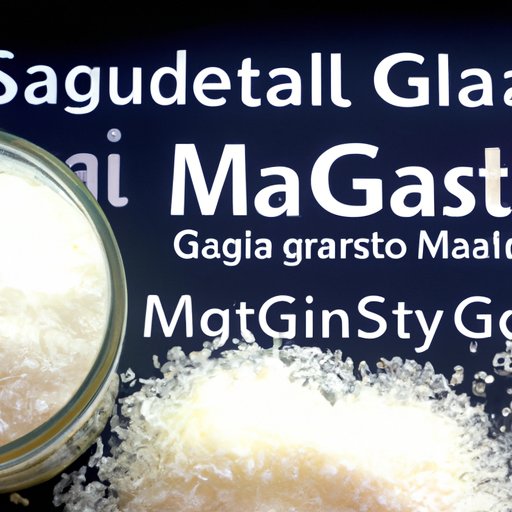Introduction
Monosodium glutamate (MSG) is a flavor enhancer commonly added to processed and packaged foods. While it has been used for centuries in Asian cuisine, today it can be found in everything from soup to snacks. But what does this food additive do to our bodies, and is it healthy? In this article, we’ll explore the pros and cons of MSG in food and examine the latest research to help you make an informed decision about its use in your diet.

Exploring the Pros and Cons of MSG in Food
When it comes to MSG in food, there are both benefits and risks to consider. Let’s take a closer look at each side.
Benefits
The main benefit of MSG is that it enhances the flavor of food. This makes it a popular choice for restaurants, snack manufacturers, and home cooks alike. According to registered dietitian nutritionist and spokesperson for the Academy of Nutrition and Dietetics, Nicole Morrissey, “MSG helps bring out the natural flavors of food, making it more palatable and enjoyable.”1
Risks
While MSG may enhance the flavor of food, it has also been linked to a number of potential health risks. The most common concern is the risk of developing symptoms known as “Chinese Restaurant Syndrome,” which include headaches, sweating, flushing, and tightness in the chest.2 Additionally, MSG has been linked to obesity, asthma, and other chronic health conditions.3
Is MSG a Healthy Choice for Your Diet?
In order to determine if MSG is a healthy choice for your diet, it is important to understand the current research on this food additive. Let’s take a closer look.
Understanding the Current Research on MSG
Research on MSG is still ongoing, and the results have been mixed. A study published in the journal Nutrients in 2016 found that MSG consumption was not linked to any adverse effects in humans.4 However, a 2017 study in the International Journal of Obesity concluded that MSG may increase the risk of obesity in certain populations.5
Alternatives to MSG
If you are looking for alternatives to MSG, there are several natural options available. These include herbs and spices such as garlic powder, onion powder, oregano, and basil. Additionally, many companies now offer organic versions of their products, which do not contain MSG or other artificial ingredients.
Examining the Potential Health Risks of MSG
While the evidence is inconclusive, there are some potential health risks associated with MSG. Let’s take a closer look at the common side effects and long-term effects.
Common Side Effects
The most common side effects of MSG consumption include headaches, sweating, flushing, and tightness in the chest. These symptoms are often referred to as “Chinese Restaurant Syndrome,” and they usually occur within minutes of consuming MSG-containing foods.2
Long-Term Effects
While the research is still inconclusive, some studies have suggested that MSG consumption may be linked to long-term health issues such as obesity, asthma, and other chronic illnesses.3 It is important to note, however, that these studies were conducted on animals, and the results may not necessarily apply to humans.

The Science Behind MSG: How it Affects Your Body
So how exactly does MSG affect the body? Once consumed, MSG is broken down by enzymes in the digestive system into its component parts: glutamate, sodium, and water. Glutamate is then absorbed into the bloodstream and transported to the brain, where it acts as an excitatory neurotransmitter.6 This means that it can stimulate the neurons in the brain, leading to increased activity and alertness.
It is important to note, however, that too much glutamate can be toxic to the brain and lead to a condition known as “excitotoxicity.” This occurs when the neurons in the brain become overstimulated, resulting in cell death and potentially serious neurological damage.7
What You Need to Know About Monosodium Glutamate (MSG)
Now that we have explored the potential health benefits and risks of MSG, let’s discuss how to identify products containing MSG and manage your intake.
How to Identify Products Containing MSG
MSG can be found in many processed and packaged foods, including soups, sauces, chips, and snacks. To identify products containing MSG, look for ingredients such as autolyzed yeast, hydrolyzed protein, calcium caseinate, and yeast extract. Additionally, many products will display “No MSG Added” on the label.
Managing Your Intake of MSG
If you are concerned about the potential health risks associated with MSG, the best way to manage your intake is to limit your consumption of processed and packaged foods. Choose fresh, whole foods whenever possible, and opt for organic versions of your favorite snacks and condiments. Additionally, you can use herbs and spices to add flavor to your meals instead of relying on MSG.
Conclusion
Monosodium glutamate (MSG) is a common food additive used to enhance the flavor of food. While it may provide some flavor benefits, there are potential health risks associated with its consumption. It is important to understand the current research and take steps to manage your intake of MSG in order to ensure your safety and well-being.
(Note: Is this article not meeting your expectations? Do you have knowledge or insights to share? Unlock new opportunities and expand your reach by joining our authors team. Click Registration to join us and share your expertise with our readers.)
